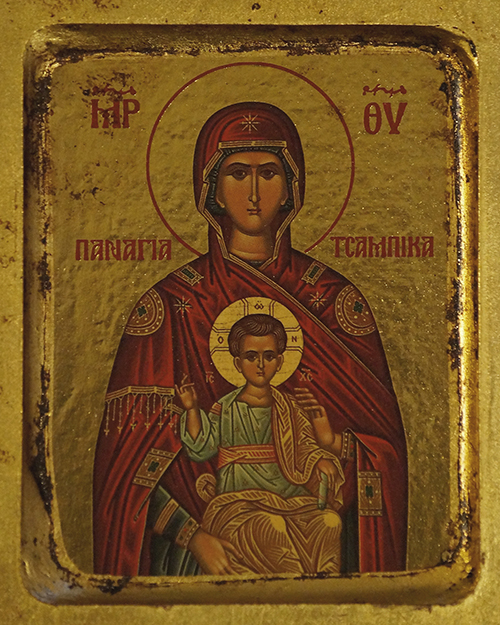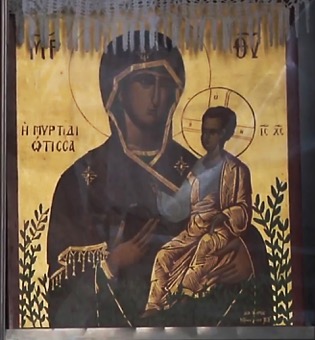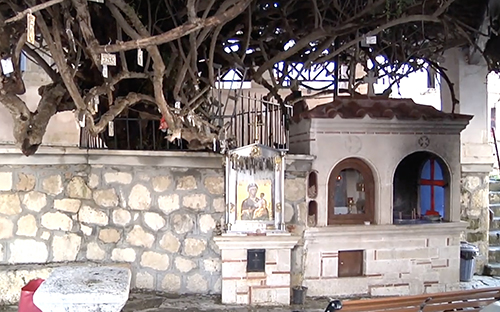2021.03.27 | By Gregory Nagy
§0. I recall here the happy occasion of my most recent viewing, in the year 2014, of the famous ancient Myrtiá (Μυρτιά) or ‘Myrtle Tree’ growing on the hallowed grounds of an old monastery, now a nunnery, in Palianí (Παλιανή), not much more than 20 kilometers southwest of Iráklio (῾Ηράκλειον), the ‘City of Herakles’, on the island of Crete. This enormous old tree, the myriad branches of which overshadow a great part of the visual space in the courtyard of the nunnery, is sacred to ‘Holy Mary’ (Ἁγία Μαρία) the Theotókos or ‘Mother of God’, as she is venerated by Greek Orthodox Christians, and she is known more specifically to the local population by way of the epithet Myrtidiṓtissa (Μυρτιδιώτισσα), ‘Our Lady of the Myrtles’. For a classicist like me, such an epithet can be described as “particularized,” by contrast with the “generic” epithet Panagía (Παναγία), which means ‘All-Holy’, and which is a generalizing way of referring to the Theotókos, whom Orthodox Christians equate with ‘Holy Mary’ as Mother of God-as-an-infant-Christ. In the first picture here, which I use as the introductory illustration for this essay, I show an icon where the Panagía and the boy-Christ are visualized within a frame of myrtle sprays. Thus a generalized Panagía can be envisioned as a particularized Myrtidiṓtissa or Lady of the Myrtles. This particular icon is what visitors can see in the courtyard dominated by the Myrtle Tree—and what I saw most recently in 2014, when I last visited the Tree, in the context of leading an intergenerational group of participants in a travel-study program. The second picture, underneath the introductory illustration provided in the first picture, is a “zoom-out” showing the context of the first picture. We see here that the visualization of ‘Our Lady of Myrtles’ as an icon is physically linked with the space dominated by the Myrtle Tree. And then, underneath the second picture, the third picture is a freeze-frame taken from a videography showing the moment when our group enters into the space shaded by the myriad branches of the Myrtle (and I can see me too there, from behind). This third picture signals what is essential for me to show in this essay: that the link between the Myrtle and ‘Our Lady of Myrtles’ is not just physical but mental as well, since the space that is marked by the Tree is thought to be sacred, and the sacredness is aetiologized—is given meaning—in the form of a sacred narrative about what I describe, in the title of my essay, as “heavenly origins.” And this narrative is encapsulated in the particularized epithet Myrtidiṓtissa, meaning ‘Our Lady of Myrtles’. After making my argument about this epithet Myrtidiṓtissa, I will show another example of such a particularized epithet as applied to the Panagía, which I will analyze in terms of another sacred narrative about “heavenly origins.”
§1. The proof, as it were, for the heavenly origins of the icon visualizing the Myrtidiṓtissa can be found in the simple fact that the icon that we see being venerated on the hallowed grounds of the Myrtle Tree when we visit the sacred space of the Myrtidiṓtissa in Palianí is in fact not the original icon. That is to say, the narrative that is actually linked with the primary icon on display at Palianí and with any and all other icons visualizing the Myrtidiṓtissa is not original. In terms of the narrative, there is no original to be seen anywhere. And that is because, in terms of the narrative itself, the original is lodged inside the enormous trunk of the Myrtle Tree. Once upon a time, according to the narrative, the Panagía made a heaven-sent appearance, an epiphany, at Palianí, and she was seen holding sprays of myrtle. This epiphany materialized into the original icon, but the sprays of myrtle as visualized in this original icon became, physically, the Myrtle Tree itself, and this tree as it kept growing over vast stretches of time enclosed the original within its ever-thickening trunk, so that all the existing icons of the Myrtidiṓtissa are “now” copies of the original which has been forever sealed inside the Myrtle Tree, to be visualized mentally from inside the Tree, yes, but not to be seen physically from outside the Tree.
§2. If I were to paraphrase this sacred narrative in terms of Plato’s Theory of Forms, then the ideal icon of the Myrtidiṓtissa would exist as a Form, or, to say it in Plato’s Greek, as an eîdos or idéā. Such is the ideal for all existing icons of the Myrtidiṓtissa. And I would posit comparable ideologies, no longer extant, to my knowledge, of other traditions localized in other places where the Panagía is venerated as the Myrtidiṓtissa (Μυρτιδιώτισσα), ‘Our Lady of the Myrtles’. The Panagía is venerated both by way of this “particularized” epithet and by way of icons showing her enclosed within a frame shaped by sprays of myrtle—not only on the island of Crete but also at other places, as on the islands of Cythera and Chios—and even on the mainland of Attica.

§3. Now I come to the comparison that I anticipated at the beginning of this essay. I compare here one other such “particularized” epithet, Tsambíka (Τσαμπίκα), which is a name applied to the Panagía as she is venerated at a shrine located on a mountaintop in Rhodes. In this case as well, the “particularized” epithet is linked with a sacred narrative that aetiologizes a localized version of venerating the Panagía. Once upon a time, according to this narrative, a herdsman sees something sparkling from far away on a mountaintop. He ascends the mountain and finds there an icon of the Panagía, surrounded by flames. Here again I see a visualization of “heavenly origins.” I thus propose to translate this particularized epithet as ‘Our Lady of the Sparks’—which is a name that I think must be derived from the noun tsámba (τσάμπα), meaning ‘spark, flash, flame’. This noun is local to a dialect deriving from a region of Cyprus, and researchers have traced back to the same region the ongoing custom, in Rhodes, of venerating the Panagía as Tsambíka (http://www.imr.gr/article/430/iera-monh-panagias-tsampikas).

§4. In both cases of local veneration for the Panagía, signaled by icons visualizing a Myrtidiṓtissa in Crete and a Tsambíka in Rhodes, the primary function of ‘Our Lady’ is to grant to her devotees good health—including, in particular, fertility. That is why, for example, women in Rhodes who are infertile can pray especially to Tsambíka to make them fertile, vowing, if their prayer is granted, to give the name Tsambíka to a baby girl and Tsambíko to a baby boy. Such is the custom in Rhodes, attested to this day.
§5. In closing, I analyze briefly a comparable situation at Palianí in Crete. It has to do with the word táma (τάμα, from τάγμα), derived from the verb tázō (τάζω, classical τάσσω). This word táma refers to a votive offering that you vow to give as a gift to, say, the Panagía in return for a favor that you pray she will do for you. And the word tázō would refer to the action of making such a vow. Accordingly, in the case of the Myrtle Tree of Palianí, as we look again at the second picture that I showed in this essay, we see hanging from its branches what are called támata, which usually take the form of silver pendants bearing images or inscriptions indicating some favor that has been granted by the Panagía Myrtidiṓtissa. I should add that my use of the word ‘favor’ in these contexts evokes the meaning of the ancient Greek word kháris. In any case, the támata that we can see hanging from the branches of the Myrtle Tree are precious objects that are votive offerings. But the támata in repayment of favors granted by the Panagía Myrtidiṓtissa do not have to be objects. They can even be persons. Thus an infertile woman, for example, could vow to give her own child as a counter-gift to the Panagía in return for the gift of fertility, and this counter-giving could take the simple form of dedicating your child by naming him or her after the Panagía. On the occasion of an earlier visit of mine to Palianí, I cannot remember exactly when, I actually heard a lady say about her sub-teen-age son, whom she had brought along with her on a sentimental pilgrimage to the Myrtle Tree: τον έταξα ‘I vowed him’. Of course the boy, however embarrassed he seemed at the moment, did not have to share the destiny of the pendants we saw hanging from the branches of the Myrtle Tree: unlike those other támata functioning as stationary votive objects offered by other devotees, this votive offering was a walking and talking táma who did not have to stay behind in Palianí after his mother was finished with her devoted thank-you to ‘Our Lady of the Myrtles’.



